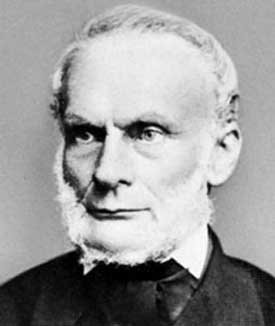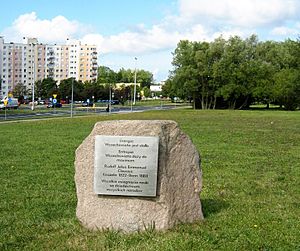Rudolf Clausius facts for kids
Quick facts for kids
Rudolf Clausius
|
|
|---|---|
 |
|
| Born | 2 January 1822 |
| Died | 24 August 1888 (aged 66) |
| Nationality | German |
| Known for | Second law of thermodynamics Originator of the concept of entropy Clausius-Mossotti relation Clausius-Clapeyron relation Clausius theorem Clausius–Duhem inequality Virial theorem Disgregation |
| Awards | Copley Medal (1879) |
| Scientific career | |
| Fields | Physics |
| Signature | |
 |
|
Rudolf Julius Emanuel Clausius (born January 2, 1822 – died August 24, 1888) was a German physicist and mathematician. He is known as one of the main founders of the science of thermodynamics. This is the study of how heat, work, and energy are related.
Clausius improved on the ideas of Sadi Carnot about the Carnot cycle. This helped make the theory of heat more accurate. In 1850, he published a very important paper called "On the Moving Force of Heat". In this paper, he first explained the main ideas of the second law of thermodynamics. Later, in 1865, he introduced the important idea of entropy. In 1870, he also came up with the virial theorem, which is used in the study of heat.
Contents
Life of Rudolf Clausius
Rudolf Clausius was born in a town called Köslin (which is now Koszalin, Poland). This was in a part of Prussia called the Province of Pomerania. His father was a pastor and also worked as a school inspector. Rudolf went to his father's school when he was young.
In 1838, he moved to a Gymnasium (a type of high school) in Stettin. Clausius then went to the University of Berlin in 1840. There, he studied mathematics and physics. Some of his teachers were famous scientists like Gustav Magnus and Peter Gustav Lejeune Dirichlet. He also studied history.
Clausius earned his doctorate degree in 1848 from the University of Halle. His studies focused on how light behaves in Earth's atmosphere. In 1850, he became a physics professor at the Royal Artillery and Engineering School in Berlin. He also taught at Berlin University.
In 1855, he became a professor at the ETH Zürich in Switzerland. He stayed there until 1867. After that, he moved to Würzburg and then to Bonn in 1869.
During the Franco-Prussian War in 1870, Clausius helped by organizing a group to assist wounded soldiers. He was hurt in battle himself, which caused him a lasting injury. For his bravery, he received the Iron Cross award.
Sadly, his wife, Adelheid Rimpau, passed away in 1875. This left him to care for their six children. In 1886, he married Sophie Sack, and they had another child together. Rudolf Clausius died two years later, on August 24, 1888, in Bonn, Germany.
Rudolf Clausius's Work
Clausius's PhD paper looked at how light bends, or refracts. He suggested that the blue sky we see during the day, and the red colors at sunrise and sunset, were due to light reflecting and refracting. Later, another scientist named Lord Rayleigh showed that it was actually due to light scattering. Still, Clausius used a very mathematical way to study these ideas.
His most famous paper was published in 1850. It was called Ueber die bewegende Kraft der Wärme (which means "On the Moving Force of Heat and the Laws of Heat which may be Deduced Therefrom"). This paper was about the mechanical theory of heat. In it, he showed that there was a problem between Carnot's ideas and the idea of conservation of energy.
To fix this problem, Clausius restated the two main laws of thermodynamics. These laws explain how energy works in systems. This paper made him very well-known among scientists.
Clausius's most famous way of explaining the second law of thermodynamics was published in 1854. It says:
Heat can never pass from a colder to a warmer body without some other change, connected therewith, occurring at the same time.
This means heat naturally flows from hot to cold, and you need to do work to make it go the other way.
In 1857, Clausius also helped develop the kinetic theory of gases. This theory explains how gases behave based on the movement of their tiny particles. He improved on earlier models by including how molecules move in different ways, like spinning and vibrating. In the same work, he introduced the idea of 'Mean free path'. This is the average distance a particle travels before hitting another particle.
Clausius also figured out the Clausius–Clapeyron relation using thermodynamics. This relation helps describe how matter changes from one state to another, like when ice melts into water. This idea was first developed by Émile Clapeyron in 1834.
What is Entropy?
In 1865, Clausius was the first to give a mathematical way to describe the idea of entropy. He also gave it its name. He chose the word "entropy" because it comes from Greek words meaning "in" and "transformation." So, it means "transformation content" or "how much energy is spread out."
Clausius used a unit called 'Clausius' (symbol: Cl) for entropy, but this unit is not used anymore.
- 1 Clausius (Cl) = 1 calorie per degree Celsius (cal/°C) = 4.1868 joules per kelvin (J/K)
His important 1865 paper, where he introduced entropy, ends with a summary of the first and second laws of thermodynamics:
The energy of the universe is constant.
The entropy of the universe tends to a maximum.
This means the total energy in the universe always stays the same. But the amount of "disorder" or "spread-out energy" (entropy) in the universe is always increasing.
Tributes and Awards
Rudolf Clausius received many honors and awards for his important work:
- He became an Honorary Member of the Institution of Engineers and Shipbuilders in Scotland in 1859.
- He received the Iron Cross in 1870 for his service in the war.
- He became a Fellow of the Royal Society of London in 1868. He was also given their Copley Medal in 1879.
- He became a Member of the Royal Swedish Academy of Sciences in 1878.
- He received the Huygens Medal in 1870.
- He was made a Foreign Member of the Accademia Nazionale dei Lincei in Rome in 1880.
- He became a Member of the German Academy of Sciences Leopoldina in 1880.
- He won the Poncelet Prize in 1883.
- He received an honorary doctorate degree from the University of Würzburg in 1882.
- He was made a Foreign Member of the Royal Netherlands Academy of Arts and Sciences in 1886.
- He received the Pour le Mérite for Arts and Sciences in 1888, a very high honor in Prussia.
- A lunar crater, Clausius, was named after him.
- A memorial was placed in his hometown of Koszalin in 2009.
Images for kids
See also
 In Spanish: Rudolf Clausius para niños
In Spanish: Rudolf Clausius para niños






